本课程将帮助您了解婴幼儿和幼儿如何在情感上发展。如果您关注婴儿或幼儿的发展,您将了解社交情感里程碑和该怎么办。
辅助标签
- Identify social-emotional milestones in infants and toddlers.
- Discuss the role adults can play in supporting the social-emotional skills of infants and toddlers.
- 讨论您关注您在护理中婴儿或幼儿的社交情绪发展的情况下该怎么办。
Learn
Know
Emotional well-being during the early years has a powerful impact on social relationships. Children who are emotionally healthy are better able to establish and maintain positive relationships with adults as well as with peers. Social-emotional development is essential to a young child’s sense of well-being. Their first relationships help shape who they are, who they become, and their understanding of the world. The important people in young children’s lives help lay the foundation for a range of social-emotional skills such as:
- Self-regulation
- 共情
- Turn-taking and sharing
- 与成年人和同龄人的积极关系
Social-Emotional Milestones
通过耳朵ly relationships and with nurturing, responsive interactions, infants and toddlers learn ways of being in relationships, how to get their needs and wants met, and how to identify and regulate emotions. Because these skills develop together, this area of development is referred to as social-emotional development.
Below is a chart that highlights how infants and toddlers develop social-emotional skills at different ages. Keep in mind that individual differences exist when it comes to the precise age at which infants and toddlers meet these milestones. As highlighted in the Cognitive, Physical, and Communication courses, milestones are not checklists with which to judge children’s development. Rather, they provide a guide for when to expect certain skills or behaviors to emerge in young children so you are ready to meet their needs. Think of milestones as guidelines to help you understand and identify typical patterns of growth and development in infants and toddlers or to help you know when and what to look for as they develop. You can continue to use your knowledge of these milestones to help meet the needs of infants and toddlers in your care. Even though the skills highlighted in the chart develop in a predictable sequence over the first three years of life, each infant and toddler is unique. Your goal is to help全部infants and toddlers grow and learn to their potential.
婴儿和幼儿社会情感发展里程碑
Use the menu at left or the pager below to cycle through scenarios
- 知道熟悉的面孔,并开始了解某人是否是一个陌生人
- Likes to play with others, especially parents
- 回应别人的情绪,往往似乎很开心
- Likes to look at self in mirror
- Is shy or nervous with strangers
- Cries when Mom or Dad leaves
- Has favorite things and people
- 在某些情况下表现出恐惧
- Hands you a book when he or she wants to hear a story
- 重复听起来和动作以引起关注
- Puts out arm or leg to help with dressing
- Plays games such as “peek-a-boo” and “pat-a-cake”
- Likes to hand things to others as play
- May have temper tantrums
- May be afraid of strangers
- Shows affection to familiar people
- 播放简单的假装,如喂娃娃
- May cling to caregivers in new situations
- 要展示其他人有趣的事情
- 探索s alone but with a parent close by
- Copies others, especially adults and older children
- 与其他孩子一起兴奋
- 显示越来越多的独立性
- Shows defiant behavior (doing what she or he has been told not to do)
- Plays mainly beside other children, but is beginning to include other children, such as in chase games
- Copies adults and friends
- Shows affection for friends without prompting
- 轮流进入游戏
- Shows concern for a crying friend
- 了解“我”和“他”或“她”的想法
- 显示了广泛的情绪
- 从妈妈和爸爸轻松分开
- May get upset with major changes in routine
- 穿着和脱衣服自我
It is helpful to remember that expectations about social-emotional milestones are driven by cultural values and preferences. Theorist Lev Vygotsky said that adults share their cultural values and beliefs with children through daily interactions. Ideas, beliefs and expectations about child development are just some of the ways cultures are unique. Becoming aware of and respecting these differences can help you better understand families’ experiences that help shape the infants and toddlers in your care.
Connection of Social-Emotional Development to Other Areas of Development
With our evolving understanding of brain growth and young children’s development, we continue to learn about the ways adult caregivers can be supportive and most effective in helping children develop and learn. This growing understanding also includes how adult caregivers can help children develop social-emotional skills. Through nurturing and trusting relationships, infants and toddlers learn about the world. Their brains mature through interactions, and they can learn that the world is safe as adults are responsive to young children’s needs. They also learn how to form relationships, communicate, respond to challenges, and how to recognize, experience, and regulate their emotions from relationships with caregivers. When infants and toddlers feel safe and alert, they are more likely to observe, explore, play, interact and experiment with people and objects. These experiences lead young children to learn and remember new things. This foundation for learning depends greatly on the quality of infants’ and toddlers’ early environments and relationships.
Understanding and Supporting the Social-Emotional Development of Infants and Toddlers
Now that you have read the milestone chart, let’s revisit the definition of social-emotional development according to Zero to Three:
Within the context of one’s family, community and cultural background, social emotional health is the child’s developing capacity to形成安全的关系,体验和规范情绪,探索和学习。
Below, take a closer look at the components highlighted within this definition to identify additional ways to understand and support the social-emotional development of the infants and toddlers in your care.
Birth to 3 months:
- 前三个月是关于帮助婴儿学会感到安全,舒适,安全,对其世界的好奇的时机。“Your smile and gentle touch help me to feel safe and happy.”
- When caregivers respond to an infant’s cues with comfort and care, infants develop trust.“你舒缓的声音和触摸帮助我感到安全,安全和喜爱。”
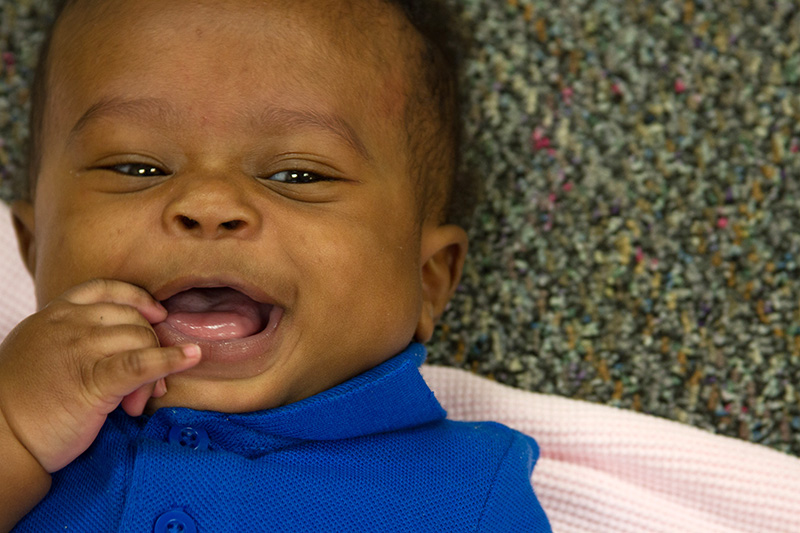 Infants use sounds, facial expressions, and body movements to tell caregivers what they need and how they are feeling.“我正在学习狗万app怎么下载如何告诉你我需要什么。有时我需要休息时瞧不起。当我感到疲倦时,我有时哈欠。谢谢你看着我了解我。“
Infants use sounds, facial expressions, and body movements to tell caregivers what they need and how they are feeling.“我正在学习狗万app怎么下载如何告诉你我需要什么。有时我需要休息时瞧不起。当我感到疲倦时,我有时哈欠。谢谢你看着我了解我。“
3 to 6 months:
- 婴儿积极,响应,越来越多地控制他或她的身体。“当我希望你接我并轻轻地抱着我时,我向你伸展双臂。”
- Infant offers smiles and communicates with a gaze and basic vocalizations.“我微笑着让你知道我准备沟通。”
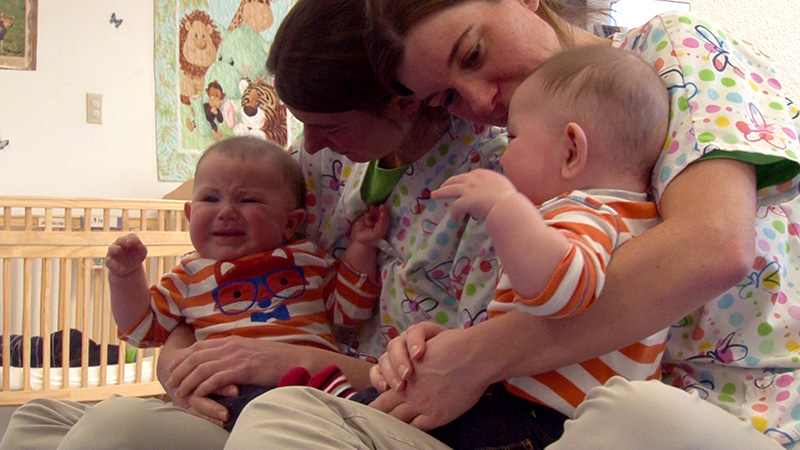 安全感和幸福感完全依赖与重要照顾者的关系。
安全感和幸福感完全依赖与重要照顾者的关系。- Emphasis is on routine and exploration—showing caregivers what they like and dislike, and how they prefer to sleep, eat, and play.“I’m beginning to notice daily routines and the things we do together. When you turn the lights down, I know that it is time for sleep.”
6 to 9 months:
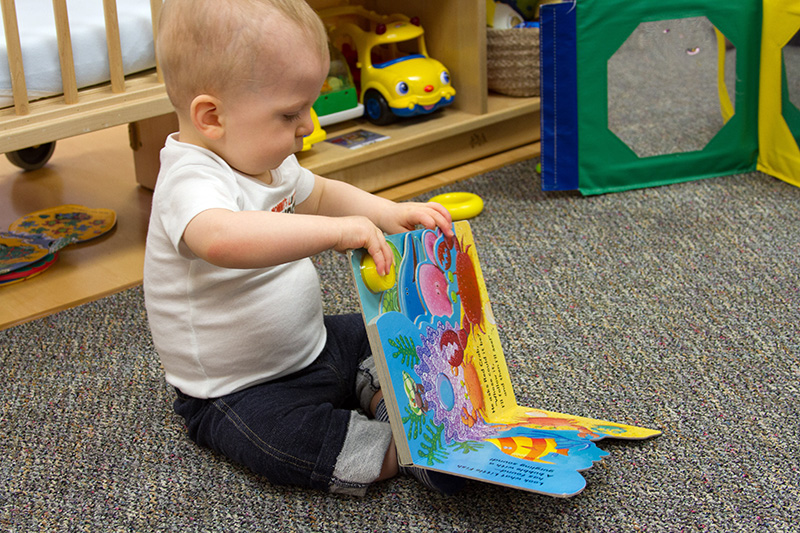 Moving and exploring is the goal – infants become eager explorers who are thrilled to discover that they can make things happen.
Moving and exploring is the goal – infants become eager explorers who are thrilled to discover that they can make things happen.- Infants are learning to solve problems.“When a toy drops, I look to see where it went. I expect you will help me to get it back. I then try it again to see if I can make the same thing happen again.”
- An infant is beginning to understand that people still exist even when they are out of sight.“I realize that my mommy is about to leave me. I will protest in hopes that she stays. Being separated from her is hard for me.”
9 to 12 months:
- Infants are enjoying increased independence.“即使我要求自己做事,请保持平静。这对我来说很努力,学习和弄清楚所有这些新事物,有时候我会受到沮丧,但我想继续尝试。“
- 婴儿可以比口头沟通更多地了解更多。
- Infants enjoy doing things over and over again.“看着我练习并弄清楚事情是如何工作!重复也在帮助我构建我的记忆!“
- Infants take action with a goal in mind.“当我快速爬行时,我并不试图让你心烦意乱。我很开心,不要现在尿布改变。这就是我如何控制我的世界,让你知道我的感受。请与我说话,让我时间从我的活动过渡,让我知道,当我们完成时,我可以回到我正在做的事情。“
12 to 18 months:
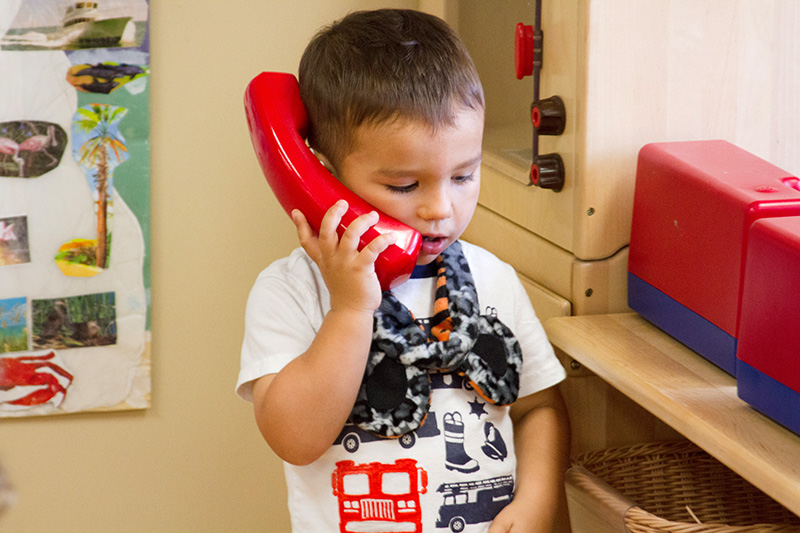 婴儿和幼儿正在观看别人并模仿他们所看到的东西。“I have been watching and am able to use things the way they are supposed to be used. Watch me talk on this toy telephone!”
婴儿和幼儿正在观看别人并模仿他们所看到的东西。“I have been watching and am able to use things the way they are supposed to be used. Watch me talk on this toy telephone!”- Infants and toddlers are using skills to explore and discover the boundaries of what they can do.“I may get frustrated when you try to feed me and I want to do it on my own.”
- 婴儿和幼儿开始了解自我和他人的感受。“My feelings can be hard for me to handle. I may become frustrated and have tantrums. I need your help to calm down.”
18至24个月:
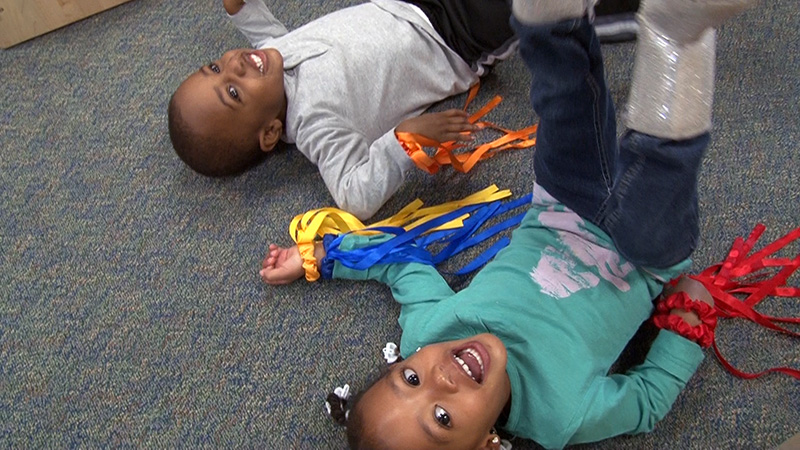 Toddlers work hard to be in control, explore the boundaries of their experiences, and engage in problem solving.“I am beginning to sort things. Notice how I put my train cars in one place and all of my other cars in another.”
Toddlers work hard to be in control, explore the boundaries of their experiences, and engage in problem solving.“I am beginning to sort things. Notice how I put my train cars in one place and all of my other cars in another.”- 他们越来越意识到自己与他人分开,并且与同龄人一起玩得更热情。
- 他们开始以令人沮丧地展示负行为(打击,咬,踢)。“I understand, ‘No,’ but cannot control my feelings and actions. Please be patient and help me when I get frustrated.”
24 to 36 months:
 Toddlers are using language to express thoughts and feelings.“When you started to put the blocks away too soon, I yelled, ‘That’s not right!’ I wanted to make a path for the cows before we put things away.”
Toddlers are using language to express thoughts and feelings.“When you started to put the blocks away too soon, I yelled, ‘That’s not right!’ I wanted to make a path for the cows before we put things away.”- Toddlers are using enhanced thinking skills to solve problems.“我真的很擅长玩假装。我可以采取自己的故事,并使用瓶子喂我的泰迪熊。有时候,我觉得害怕,因为我不确定是真实的,什么是假装。“
- Toddlers take pride in their accomplishments, such as, pouring milk.
Supporting All Infants and Toddlers
Every child is born with her or his unique way of approaching the world. This is called气质。Some young children, for example, are constantly on the move while others prefer to sit and watch the world around them. Some young children enjoy new experiences and meeting new people while others are slower to warm up in new situations. Rothbart (1989) defined temperament as the individual personality differences in infants and young children. As Murphy and Moon describe, “infants and young children vary greatly in their interest in different sensory areas, in the intensity of their attention to sensory stimuli, and in their sensitivity to feelings of comfort and discomfort, familiarity and strangeness, and the emotional context in which sensory experiences occur.”
Infants are born with a unique temperament. There is no right or wrong, good or bad temperament. By understanding temperament, you can continue to use what you know about infants and toddlers to encourage their strengths and support their needs. In the Apply section you will review more information about temperament and consider what it means for your role as a responsive caregiver.
No matter how well you understand temperament and are attuned and responsive, there will be times that an infant or toddler in your care may not seem to be developing socially and emotionally. Some infants and toddlers may experience social or emotional difficulties. These difficulties may be related to inborn (nature) or environmental (nurture) influences. The caregiving strategies in this lesson apply and relate to all children; however, some children may require an additional level of support.
Each infant’s or toddler’s relationship experiences and pattern of growth is different. In your work, you observe and track each young child’s particular strengths and possible areas of need. Your screening and assessment process is part of your ongoing routine, and it helps you to recognize and celebrate infants’ and toddlers’ accomplishments. It also helps you to identify red flags—some aspect of the infant’s or toddler’s development that is outside the expected age range.
以下一般策略可以帮助您关心正在经历社会和情感困难的婴儿和幼儿。您还可以与您的主管,培训师或教练讨论其他社区资源和支持您的计划的专家,他们可以提供额外的支持。
- Observe and notice the infant’s or toddler’s cues and responses to environmental stimuli. Think about ways to limit noise level, for example, or visual stimuli.
- 观察并询问自己如果您发现在特定惯例或一天中的婴儿或幼儿中提高了令人沮丧或烦躁。
- Think about ways to maintain physical closeness and offer gentle touch to help infants and toddlers maintain a sense of control.
See
在婴儿和幼儿促进社会情感发展
Do
You can promote social-emotional development of infants and toddlers in several ways:
- Respond to infant and toddler’s needs in caring ways.
- Acknowledge an infant's or toddler who points to a picture of himself or his family –“That’s right, Bobby, that is a picture of you and your dad!”
- Model caring behaviors and empathy during all interactions.
- Read stories about and show infants and toddlers pictures of different emotions.
- 与您的护理中与婴儿和幼儿家属建立强有力的关系。
探索
花点时间列出您认为表明健康的社交情绪发展的行为。将您的列表与本课程图表中所指出的行为进行比较。接下来,下载讲义,Encouraging Social-Emotional Development During the First Three Years。在思考您的护理中思考婴儿和幼儿时,突出您经常注意到的行为以及在生命的前三年中可以鼓励这些行为的方式。然后,与培训师,教练或主管分享并讨论您的回复。
Apply
Download and print the handout,狗万app怎么下载了解更多关于气质的, which contains links to additional resources you can use to explore and better understand temperament of infants and toddlers.
Glossary
| Term | 描述 |
|---|---|
| Developmental delay | This may be suspected when children do not meet developmental milestones at the expected times; delays can occur in any area of development |
| Developmental milestones | 大多数孩子在某个年龄范围内可以做的一套技能或行为 |
| 发展筛选 | A tool used to help identify children who are not developing as expected and who may need supports; screening can be completed by pediatricians, teachers and others who know the child and have a knowledge of child development |
| Emotional self-regulation | The ability to adjust our emotional state to a comfortable level of intensity so we can accomplish our goals |
| Social-emotional competence | Healthy relationships with caregivers and friends, a positive self-awareness and ability to control emotions, and the ability to independently participate in daily routines and play across a variety of environments |
Demonstrate
Berk, L. E. (2013).Child Development(第9届)。上鞍河,新泽西:皮尔逊教育公司
Feldman, R. S. (2007).Child Development(4th ed.). Upper Saddle River, NJ: Pearson Education.
Murphy, L. B. & Moon, R.Babies and their senses.Zero to Three: National Center for Infants, Toddlers, and Families. Retrieved from:http://www.zerotothree.org/child-development/temperament-behavior/babies-and-their-senses.html
Rothbart, M.K. (1989). Temperament and development. In G. Kohnstamm, J. Bates, & M.K. Rothbart (Eds.),Temperament in childhood(第187-248页)。奇切斯特,英国:Wiley。
Rothbart, M. K. (2004). Temperament and the pursuit of an integrated developmental psychology.Merrill-Palmer Quarterly, 50 (4), 492–505. doi:10.1353/mpq.2004.0035. Retrieved from:http://muse.jhu.edu/journals/merrill-palmer_quarterly/v050/50.4rothbart.html
Trawick-Smith, J. W. (2014).Early Childhood Development: A Multicultural Perspective,(6th ed.). Upper Saddle River, NJ: Pearson Education.



 Infants use sounds, facial expressions, and body movements to tell caregivers what they need and how they are feeling.“我正在学习狗万app怎么下载如何告诉你我需要什么。有时我需要休息时瞧不起。当我感到疲倦时,我有时哈欠。谢谢你看着我了解我。“
Infants use sounds, facial expressions, and body movements to tell caregivers what they need and how they are feeling.“我正在学习狗万app怎么下载如何告诉你我需要什么。有时我需要休息时瞧不起。当我感到疲倦时,我有时哈欠。谢谢你看着我了解我。“ 安全感和幸福感完全依赖与重要照顾者的关系。
安全感和幸福感完全依赖与重要照顾者的关系。 Moving and exploring is the goal – infants become eager explorers who are thrilled to discover that they can make things happen.
Moving and exploring is the goal – infants become eager explorers who are thrilled to discover that they can make things happen. 婴儿和幼儿正在观看别人并模仿他们所看到的东西。“I have been watching and am able to use things the way they are supposed to be used. Watch me talk on this toy telephone!”
婴儿和幼儿正在观看别人并模仿他们所看到的东西。“I have been watching and am able to use things the way they are supposed to be used. Watch me talk on this toy telephone!” Toddlers work hard to be in control, explore the boundaries of their experiences, and engage in problem solving.“I am beginning to sort things. Notice how I put my train cars in one place and all of my other cars in another.”
Toddlers work hard to be in control, explore the boundaries of their experiences, and engage in problem solving.“I am beginning to sort things. Notice how I put my train cars in one place and all of my other cars in another.” Toddlers are using language to express thoughts and feelings.“When you started to put the blocks away too soon, I yelled, ‘That’s not right!’ I wanted to make a path for the cows before we put things away.”
Toddlers are using language to express thoughts and feelings.“When you started to put the blocks away too soon, I yelled, ‘That’s not right!’ I wanted to make a path for the cows before we put things away.”